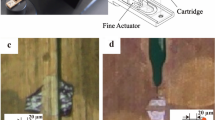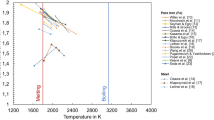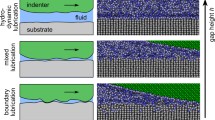Abstract
The relationship between the critical shear stress for the onset of flow instabilities and the work of adhesion at the interface has been evaluated experimentally for a series of polyolefins on several steels, brasses, and coated steels. The critical shear stress was considerably affected by the chemical nature of the die. Low-surface-energy materials were found to produce smooth extrudates presumably by inducing slippage at the wall. Steel, tungsten carbide, and brass surfaces promoted sharkskin defect at shear stresses above the first critical shear stress. A linear relationship between the critical shear stress and the work of adhesion was found to be valid for values of work of adhesion smaller than approximately 30 mN/m. This indicates that slippage occurs due to a breakdown of the adhesion at the interface. For values of work of adhesion greater than approximately 30 mN/m a stronger interaction at the interface may induce a cohesive failure at the interface and subsequently, extrudate distortions.


Similar content being viewed by others
References
Ramamurthy A (1986) Wall slip in viscous fluids and influence of material of construction. J Rheol 30(2):337–357
Kalika D, Denn M (1987) Wall slip and extrudate distortion in linear low-density polyethylenes. J Rheol 31(8):815–834
Hill D, Hasagawa T, Denn M (1990) On the apparent relation between adhesive failure and melt fracture. J Rheol 34(6):891–918
Person T, Denn M (1997) The effect of die materials and pressure dependent slip on the extrusion of linear low-density polyethylene. J Rheol 41(2):249–265
Ghanta V, Riise B, Denn M (1999) Disappearance of extrusion instabilities in brass capillary dies. J Rheol 43(2):435–442
Hill D, Denn M, Salmeron M (1994) Post-fracture analyses of polyethylene-metal interfaces. Chem Eng Sci 49:655–658
Wu S (1982) Polymer interface and adhesion. Marcel Dekker, NY
Hutton J (1965) The fracture of liquids in shear: The effects of size and shape. Proc R Soc Lond Ser A: Math Phys Sci 287:222–239
Ajji A, Schreiber H, Duchesne D (1993) Flow defects in linear low density processing: instrumental detection and molecular weight dependence. Polym Eng Sci 33(23):1524–1531
Anastasiadis S, Hatzikiriakos S (1998) The work of adhesion of polymer/wall interfaces and its association with the onset of wall slip. J Rheol 42(4):795–812
Larrazabal H, Hrymak A (2002) Flow instabilities of linear PE in capillary dies. Int Polym Process XVII(1):44–48
del Rio O, Neumann A (1997) Axisymmetric drop shape analysis: computational methods for the measurement of interfacial properties from the shape and dimensions of pendant and sessile drops. J Colloid Interface Sci 196(2):136–147
Rotenberg Y, Boruvka L, Neumann A (1983) Determination of surface tension and contact angle from the shapes of axisymmetric fluid interfaces. J Colloid Interface Sci 93(1):169–183
Wu S (1971) Calculation of interfacial tension in polymer systems. J Polym Sci Part C: Polym Symp 34:19–30
Decker E, Frank B, Suo Y, Garoff S (1999). Physics of contact angle measurement. Colloids Surf A: Physicochem Eng Asp 156:177–189
Kwok D, Neumann A (2000) Contact angle interpretation in terms of solid surface tension. Colloids Surf A: Physicochem Eng Asp 161(1):31–48
Fowkes F (1964) Attractive forces at interfaces. Ind Eng Chem 56:40–52
Kwok D, Cheung L, Park C, Neumann A (1998) Study on the surface tensions of polymer melts using axisymmetric drop shape analysis. Polym Eng Sci 38(5):757–764
Drelich J, Miller J, Good R (1996) The effect of drop (bubble) size on advancing and receding contact angles for heterogenous and rough solid surfaces as observed with sessile-drop and captive-bubble techniques. J Colloid Interface Sci 179(1):37–50
Hatzikiriakos S, Dealy J (1991) Wall slip of molten high-density polyethylene I. Sliding plate rheometer studies. J Rheol 35(4):497–523
Hatzikiriakos S, Dealy J (1992) Wall slip of molten high-density polyethylene II. Capillary rheometer studies. J Rheol 36(4):703–741
Hatzikiriakos S (1993) A slip model for linear polymer based on adhesive failure. Int Polym Process VIII(2):135–142
Author information
Authors and Affiliations
Corresponding author
Rights and permissions
About this article
Cite this article
Larrazabal, H., Hrymak, A. & Vlachopoulos, J. On the relationship between the work of adhesion and the critical shear stress for the onset of flow instabilities. Rheol Acta 45, 705–715 (2006). https://doi.org/10.1007/s00397-005-0028-4
Received:
Accepted:
Published:
Issue Date:
DOI: https://doi.org/10.1007/s00397-005-0028-4




